Ocean Exploration Fiscal Year 2021 Funding Opportunity Awards
Through the Ocean Exploration Fiscal Year (FY) 2021 Funding Opportunity, NOAA Ocean Exploration selected eight projects for financial support totaling approximately $3.5 million. For the FY21 competition, we solicited proposals to map, explore, and characterize deep waters of the U.S. Exclusive Economic Zone to improve understanding of the vast ocean resources of the nation and to advance economic, health, security, and environmental interests. Priorities were focused on interdisciplinary baseline characterizations of unknown or poorly known deep-ocean areas, processes, and resources; technological innovation or novel application to advance deep-ocean exploration objectives; and discovery and initial characterization of underwater cultural heritage.
The supported projects are described below.
Accelerating Ocean Exploration Through Cloud-Native Processing of Active Ocean Sonar Data
Principal Investigator: Wu-Jung Lee, Applied Physics Laboratory, University of Washington
Scientists commonly use active sonar systems to collect data about mid-trophic level animals like zooplankton and small fish, which play an important role in the marine ecosystems. Echosounders, or fish-finders, are high-frequency sonar systems that emit pulses of sound and record the reflections from animals, the seabed, and other objects. These instruments have been proven to be more efficient and effective for collecting data over a large survey area or a long time period than many other sampling methods, such as underwater imaging and net trawls. This technology has been widely adopted by the ocean science and commercial fishing communities and more recently has been integrated with autonomous vehicles, resulting in a massive amount of data. However, these datasets can be difficult to analyze and are often underutilized. This team will address this issue by developing data standards, a streamlined data processing workflow, and software tools that capitalize on recent advancements in cloud computing technologies to efficiently transform large quantities of ocean sonar data into information that is useful for exploring, monitoring, and managing living marine resources.

This project will create open-source software tools and workflow for scientists to process and interact with large volumes of ocean sonar data natively on the cloud. Image courtesy of Wu-Jung Lee; echogram courtesy of NOAA Fisheries. Download largest version (jpg, 340 KB).
Field Validation of Novel Low-Cost Underwater Robot for Deepwater Exploration and Characterization
Principal Investigator: Matthew Johnson-Roberson, University of Michigan
Deep-sea corals provide habitat for a wide variety of marine life. Despite their importance to the environment, little is known about them and the threats to their survival. Deep-sea data collection is expensive, and annotation and analysis of underwater imagery is time consuming. To help advance the protection of deep-sea coral ecosystems, this team will improve and validate a new, low-cost, open-source, autonomous underwater vehicle (AUV) and develop automatic annotation software. They will test the AUV and collect data at a site in Hawaiian waters that is known for its high diversity and density of corals. Data collected will be used to generate photometric 3D reconstructions of the seafloor and for the development of the software. This project will benefit the scientific community in two key ways: It will make deep-sea exploration more accessible to the larger scientific community and will increase the speed of data analysis and availability.
Illuminating Pelagic and Benthic Biodiversity in Deep Waters of Puerto Rico
Principal Investigator: Andrea Quattrini, Smithsonian Institution National Museum of Natural History
Deepwater habitats off the coast of Puerto Rico, including submarine canyons, ridges, and banks, are likely home to a wide variety of marine life, including commercially important species and species new to science. Yet, these habitats remain some of the least explored areas of the U.S. Exclusive Economic Zone. To better understand the biodiversity from the surface to the seafloor and what shapes it, this research team will use new technologies for water sampling, soft-bodied animal collection, low-light imaging, and 3D/virtual reality imaging to explore and characterize Puerto Rico’s deep sea. Data collected will serve as a baseline to detect and address future changes to better preserve the long-term health of the region’s vulnerable marine ecosystems and fisheries.
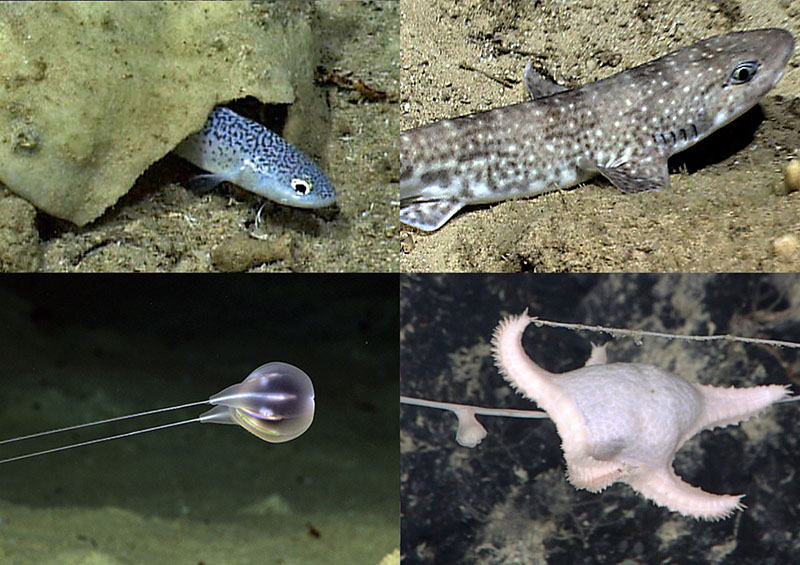
Recent discoveries made during NOAA Ocean Exploration expeditions on NOAA Ship Okeanos Explorer off Puerto Rico: (upper left) first in situ images of Neobythites unicolor (Uiblein et al. 2019) showing a distinct color pattern, (upper right) new species of catshark imaged but not collected, (lower left) new species of ctenophore Duobrachium sparksae (Ford et al. 2020), and (lower right) new species of sea star Evoplosoma nizinskiae (Mah et al. 2020). Image courtesy of NOAA Ocean Exploration. Download largest version (jpg, 721 KB).
Machine Learning for Automated Detection of Shipwreck Sites From Large Area Robotic Surveys
Principal Investigator: Katherine A. Skinner, University of Michigan
Shipwrecks can help us better understand our past, but finding and exploring them is time consuming, labor intensive, and expensive, so most of their tales remain untold. This team aims to increase the efficiency and decrease the costs associated with such exploration efforts (and ocean exploration in general) by advancing the autonomous capabilities of underwater vehicles to search for and survey shipwreck sites. To limit the need for human input, they will develop machine learning methods to detect shipwreck sites from sonar data and develop capabilities that enable underwater vehicles to automatically adapt their routes while exploring sites of interest. To test these approaches, the team will use an autonomous underwater vehicle to search for and survey known and potential shipwreck sites in the Thunder Bay National Marine Sanctuary in Lake Huron. Data collected will inform the management and conservation of these important sanctuary resources.
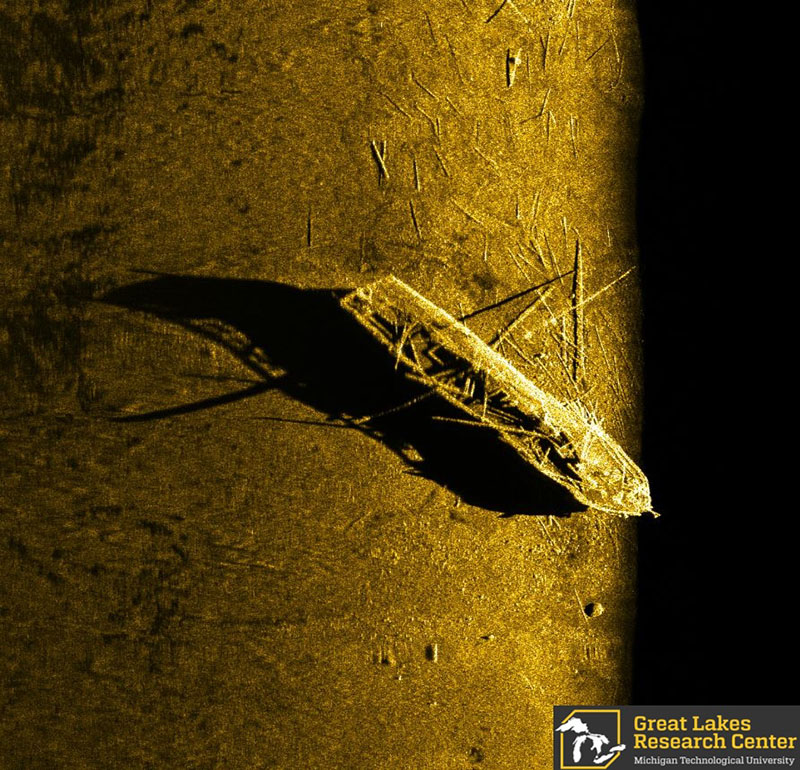
This team will use high resolution sonar data to detect shipwreck sites. This sonar image was collected with Michigan Technological University's IVER-3 autonomous underwater vehicle in Thunder Bay National Marine Sanctuary. Image courtesy of Great Lakes Research Center, Michigan Technological University. Download largest version (jpg, 646 KB).
Marine Archaeological Investigation and Mapping of the Paleo-Suwannee River, Eastern Gulf of Mexico
Principal Investigator: Vincent Lecours, University of Florida
Humans have lived in Florida for at least 14,550 years. By studying sites once occupied by the Paleoindians — the first people to enter and inhabit the Americas — we can improve our understanding of how they got here, how they survived, and how they adapted to environmental changes like sea-level rise. However, much remains to be learned, and these sites are difficult to identify and access. By combining approaches from remote sensing, archaeology, and seafloor mapping to explore the Paleo-Suwannee River channel off Florida’s Gulf of Mexico Coast, this team aims to identify and characterize areas of high archaeological significance to inform their future management and conservation. In addition, they will use innovative marine habitat mapping approaches and test new remote sensing methods to improve the discovery and characterization of archaeological sites.
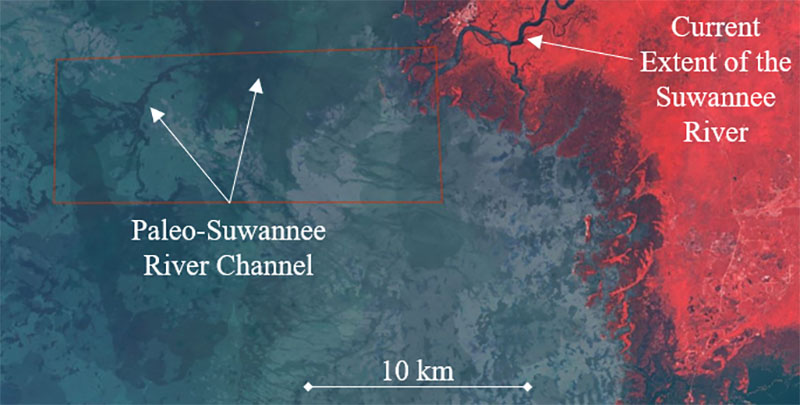
False-color multitemporal satellite image composite from 2018 showing the modern-day shoreline and Suwannee River and evidence of the Paleo-Suwannee River channel, where the team expects to find evidence of past occupation. The Sentinel-2 satellite imagery was provided by Google Earth Engine, and the image produced by Vincent Lecours. Download largest version (jpg, 206 KB).
Microbial Ecosystem Services on Seamounts Around Papahānaumokuākea Marine National Monument
Principal Investigator: Beth N. Orcutt, Bigelow Laboratory for Ocean Sciences
Polymetallic ferromanganese crusts found on seamounts frequently include critical minerals that are used in consumer electronics, defense, renewable energy industries, and more. As demand for these resources increases, so does interest in mining them. Yet, little is known about the characteristics of these crusts and the microorganisms that live on and within them. To better understand how these resources interact and their associated ecosystems, this team will explore and characterize mineral and microbial resources of seamounts within the Papahānaumokuākea Marine National Monument that are expected to have high critical mineral content. This project will result in important baseline information regarding the mineral resource potential as well as the parallel living resources of these seamounts and will be used to inform their sustainable use and conservation. This project will be done in partnership with Ocean Exploration Trust.
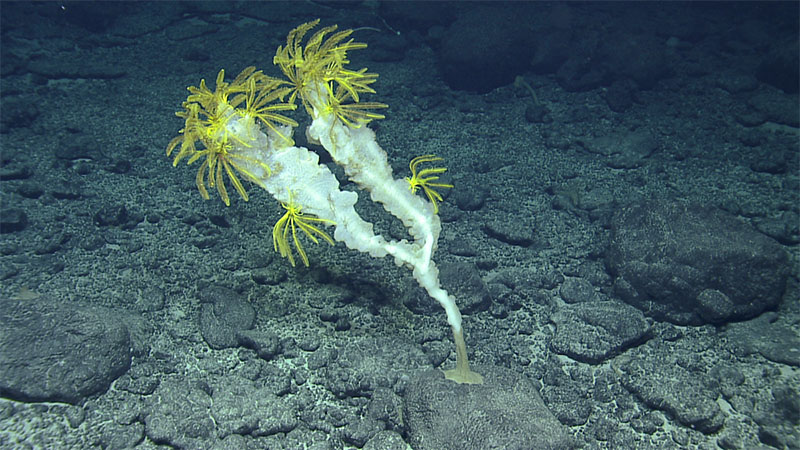
Crinoid feather stars attached to a sponge attached to an altered seafloor basalt were observed on a seamount of the Naifeh chain within the Papahānaumokuākea Marine National Monument (PMNM) during an expedition on Exploration Vessel Nautilus in 2018. This project will characterize the mineral crust and microbial resources of seamount rocks of other unexplored seamounts of the PMNM. Image courtesy of Ocean Exploration Trust. Download largest version (jpg, 824 KB).
Multi-Tiered Autonomous Vehicle-Based Survey of New and Proposed Great Lakes National Marine Sanctuaries
Principal Investigator: Russ Green, NOAA Office of National Marine Sanctuaries
Marine transport on the Great Lakes played a central role in the exploration, settlement, economic expansion, and industrialization of the nation. The estimated 6,000 shipwrecks across the five Great Lakes can help us better understand that role. Many of these shipwrecks have yet to be discovered and explored. This team will use an uncrewed aerial vehicle, an autonomous surface vehicle, and an autonomous underwater vehicle to search for shipwrecks at sites within the boundaries of the new Wisconsin Shipwreck Coast (Lake Michigan) and proposed Lake Ontario national marine sanctuaries. Their work, which could include discovery of nationally significant historic sites, such as 18th and 19th century shipwrecks and War of 1812 artifacts, will add to our knowledge of America’s past maritime-based economic activities in the Great Lakes and generate valuable new data products to support resource management efforts, including the establishment and management of national marine sanctuaries.
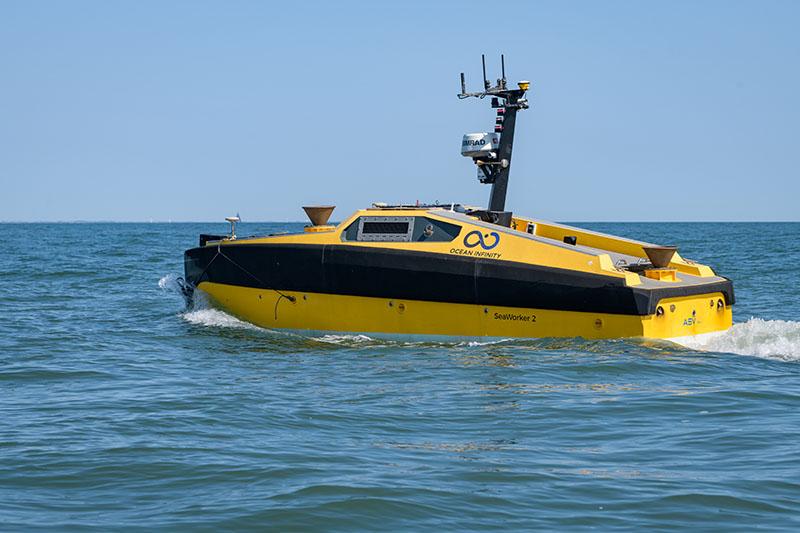
This team will use an autonomous surface vehicle like this one to search for shipwrecks in new and proposed national marine sanctuaries in the Great Lakes. Image courtesy of Evan Krape, University of Delaware; Ocean Infinity. Download largest version (jpg, 8.7 MB).
Our Submerged Past: Exploring Inundated Late Pleistocene Caves in Southeast Alaska with SUNFISH
Principal Investigator: Kristof Richmond, Sunfish, Inc.
Evidence suggests that humans have made the northwest coast of North America their home for at least 17,000 years. The land these First Peoples inhabited is now underwater. Tangible evidence of their presence should be preserved in submerged caves and rock shelters, but these features are difficult to access and have not been formally explored. To learn more about how and when people migrated to the Americas, this team will search for evidence of human occupation on the continental shelf of southeast Alaska in an area that has not been accessible to humans for over 10,000 years. Using the SUNFISH autonomous underwater vehicle, which is designed to operate in complex 3D undersea environments, the team will explore, map, and collect sediment samples from submerged caves and rock shelters. They will then analyze the data and samples collected to further inform our understanding of the past, both human and environmental.
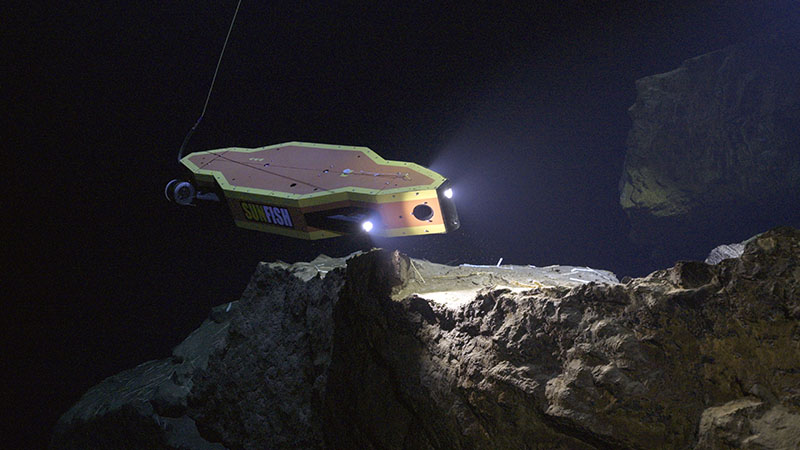
The SUNFISH exploration autonomous underwater vehicle will be used to map and sample cave sites in southeast Alaska to inform our understanding of the earliest human occupation in the area. Image courtesy of Jason Gulley/United States Deep Caving Team. Download largest version (jpg, 3.7 MB).